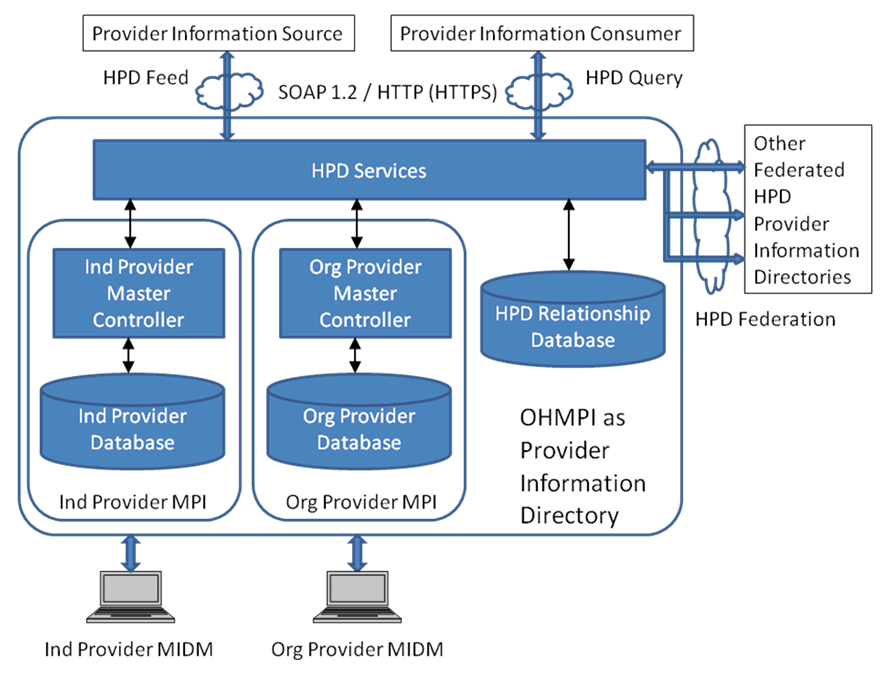| Oracle® Healthcare Master Person Index Working With HPD Profile Application User's Guide Release 3.0 E62313-01 |
|
|
PDF · Mobi · ePub |
| Oracle® Healthcare Master Person Index Working With HPD Profile Application User's Guide Release 3.0 E62313-01 |
|
|
PDF · Mobi · ePub |
This chapter provides an overview of the Healthcare Provider Directory (HPD) Application in Oracle Healthcare Master Person Index (OHMPI). It also provides links to instructions in the following chapters that help you understand and use OHMPI and the HPD Application.
This chapter includes the following sections:
Integrating the Healthcare Enterprise's (IHE) Healthcare Provider Directory (HPD) specification is available at http://www.ihe.net/uploadedFiles/Documents/ITI/IHE_ITI_Suppl_HPD.pdf. This specification is still in the Trial Implementation stage as on OHMPI 3.0 release date. It supports management (persistence and access) of healthcare provider information in a directory structure. HPD directory structure is a listing of the following two categories of healthcare providers that are classified by provider type, specialties, credentials, demographics, and service locations:
Individual Provider: A person who provides healthcare services, such as a physician, nurse, or pharmacist.
Organizational Provider: Organization that provides or supports healthcare services, such as hospital, Healthcare Information Exchange (HIE), Managed Care, Integrated Delivery Network (IDN), and Association.
OHMPI's HPD Application serves as the Provider Information Directory actor defined by IHE's HPD Profile and provides a flexible solution to healthcare integration needs. It uses processing logic based on the guidelines and standards put forth by IHE to assure compatibility with other vendors and healthcare organizations. A Provider Information Source interfaces with the Provider Information Directory to send new and updated provider information. A Provider Information Consumer interfaces with the Provider Information Directory to query provider information. Provider Information Directory can rely on other external Provider Information Directories for federation.
OHMPI's HPD support leverages the advanced standardization and matching algorithms of Master Person Index to cross-reference and uniquely identify the individual providers and organizational providers. Master Person Index provides a single complete view of the participants in the healthcare system and is able to quickly reconcile which information is associated with which provider.
The HPD Application processes HPD Feed and HPD Query messages based on the IHE IT infrastructure technical frameworks. Information about the state of the HPD Application is provided by a common logging, alerting, error handling, and reporting mechanism.
HPD Application's design-time is composed of the following three top-level NetBeans Projects:
Individual Provider MPI Project
Organizational Provider MPI Project
HPD Project
When a new HPD Project is created in NetBeans, a pre-defined Individual Provider MPI Project and a pre-defined Organizational Provider MPI Projects are also created. The three projects need to be configured, built, and deployed separately.
The out-of-box Individual/Organizational Provider MPI Project has a pre-defined MPI object model that is compatible with IHE's HPD specification. These object models cannot be modified in OHMPI 3.0. Future versions of OHMPI might support customized mapping to user-defined object model, that is, provide HPD Profile support on top of user-defined Individual/Organizational Provider MPI Project.
The HPD Project maintains the relationship between the Individual Providers and Organizational Providers. Note the difference between "HPD Project" and "HPD Application". We use the term "HPD Project" for the design-time NetBeans project, and "HPD Application" for the runtime overall HPD application.
The HPD Application Runtime has a number of components, which are illustrated in Figure 1-1. They are:
These three runtime components correspond to the three NetBeans Projects in design-time.
Figure 1-1 HPD Application Runtime Components

This component serves as the frontage for the HPD Application's Runtime. It provides the web service interface defined by IHE's HPD Profile. Behind the scene, this component interacts with:
Individual/Organizational Provider MPI component to persist and query Individual/Organizational Providers, respectively.
Relationship Manager to persist and manage group and membership relationship between Individual Providers and Organizational Providers.
HPD Web Service's interface is defined by the IHE specification. You can refer to the WSDL and XSD Schema at:
This component is the core Individual Provider identity resolution component that leverages OHMPI's powerful matching and standardization engines to uniquely identify and cross-reference individual provider objects based on a canonical individual provider object model.
OHMPI's powerful, extensible, and configurable Match Engine compares complex data records containing a multitude of data types and calculates a global composite weight that reflects how closely the records match. From this, OHMPI builds a cross-index that is used to provide a single view of the Individual Provider information from multiple source systems in real time.
Similar to Individual Provider Master Person Index, this component provides MPI functionality for Organizational Providers.
This document includes several tasks that are optional and some that are required for a production environment. The tasks are listed by category, as below.
For a production environment, you need to configure certain variables unless you specified the correct values during installation, and source systems need to be added in the Individual/Organizational Provider MPI Project. Optionally, you can configure Master Person Index processing.
Perform the following additional steps before you begin using the HPD Application:
Create HPD application databases and tables. For information, see Chapter 3, "Creating MPI and HPD Database Tables".
Configure application server resources. For information, see Configuring Application Server Resources.
If you performed a complete installation of OHMPI, you are ready to work with the HPD Application and can start running test data, and using the Master Index Data Manager (MIDM). For instructions on running test data and monitoring the processed data, see Running Data through the HPD Application.